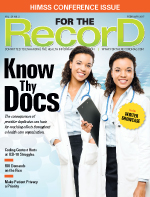February  2017
2017
By the Numbers
For The Record
Vol. 29 No. 2 P. 34
52
This percentage of health care professionals believes a Trump presidency will improve health care in the United States, 48% anticipate a positive financial impact on their practices, and 59% are optimistic that physician practices will experience a decrease in regulatory burdens, according to Aprima Medical Software's postpresidential election survey. Additionally, 62% of survey participants expect changes to some aspects of the Affordable Care Act, though less than one-third expect a total repeal; 38% predict a continuation toward plans that reward providers for cost-effective care and quality outcomes, while 40% predict a shift back to fee-for-service; and 36% anticipate access becoming more difficult, while 36% anticipate no significant impact to accessibility.
$0.03 to $2.42
According to Intel Security's McAfee Labs Health Warning report, stolen medical records have a price per record of this amount—much lower than personal financial account data, which go for $14 to $25 per record.
75
A study from SecurityScorecard found that more than this percentage of the entire health care industry had been infected with malware over the last year. Additionally, health care has the fifth highest count of ransomware among all industries.
618,966
According to a Centers for Medicare & Medicaid Services report, recovery audit contractors (RACs) identified and corrected this number of claims in fiscal year 2015, resulting in $440.69 million in improper payments being corrected—down from $2.57 billion in 2014. The decrease is primarily attributable to a ban on RACs performing patient status reviews.
9
Four out of five physician offices have EHR systems, but fewer than this percentage of physicians reported using all of the technology's major capabilities over the course of 2015, according to data from the Centers for Disease Control and Prevention's National Center for Health Statistics. Thirty-eight percent of doctors sent or received patient health information with other providers via EHR, and 30% imported patient information from another source into their EHR system.
14
The Boston Globe reports that since 2011, there have been at least this number of instances in which caregivers at Massachusetts facilities performed a procedure on the wrong patient, state records show. In at least 10 of these cases, busy or distracted caregivers failed to use two distinct pieces of information to identify a patient, such as full name and birth date. In several instances, patients did not speak English, which can raise the risk of medical errors.
5,246
In a study published in 2013 in the Journal of the American Medical Informatics Association, researchers found that this number of wrong-patient electronic medication orders were placed at Montefiore Medical Center in New York City in a single year. While providers caught these errors before causing patient harm, this means one in 37 patients admitted to the hospital had an order placed that was intended for another patient, The Boston Globe reports.



